1. GBD Chronic Respiratory Disease Collaborators. Prevalence and attributable health burden of chronic respiratory diseases, 1990-2017: a systematic analysis for the Global Burden of Disease Study 2017. Lancet Respir Med. 2020; 8(6):585–596. PMID:
32526187.
3. Lee H, Shin SH, Gu S, Zhao D, Kang D, Joi YR, et al. Racial differences in comorbidity profile among patients with chronic obstructive pulmonary disease. BMC Med. 2018; 16(1):178. PMID:
30285854.
4. Sin DD, Anthonisen NR, Soriano JB, Agusti AG. Mortality in COPD: Role of comorbidities. Eur Respir J. 2006; 28(6):1245–1257. PMID:
17138679.
5. Santos NC, Miravitlles M, Camelier AA, Almeida VD, Maciel RR, Camelier FW. Prevalence and impact of comorbidities in individuals with chronic obstructive pulmonary disease: a systematic review. Tuberc Respir Dis (Seoul). 2022; 85(3):205–220. PMID:
35618259.
6. Jo YS. Long-term outcome of chronic obstructive pulmonary disease: a review. Tuberc Respir Dis (Seoul). 2022; 85(4):289–301. PMID:
35822318.
7. Deshmukh K, Khanna A. The burden of chronic obstructive pulmonary disease in cardiovascular diseases: a non-western perspective. Tuberc Respir Dis (Seoul). 2021; 84(2):167–170. PMID:
33596375.
8. Müllerova H, Agusti A, Erqou S, Mapel DW. Cardiovascular comorbidity in COPD: systematic literature review. Chest. 2013; 144(4):1163–1178. PMID:
23722528.
9. Chen W, Thomas J, Sadatsafavi M, FitzGerald JM. Risk of cardiovascular comorbidity in patients with chronic obstructive pulmonary disease: a systematic review and meta-analysis. Lancet Respir Med. 2015; 3(8):631–639. PMID:
26208998.
10. de Lucas-Ramos P, Izquierdo-Alonso JL, Rodriguez-Gonzalez Moro JM, Frances JF, Lozano PV, Bellón-Cano JM, et al. Chronic obstructive pulmonary disease as a cardiovascular risk factor. Results of a case-control study (CONSISTE study). Int J Chron Obstruct Pulmon Dis. 2012; 7:679–686. PMID:
23055717.
11. Figueira Gonçalves JM, Dorta Sánchez R, Rodri Guez Pérez MD, Viña Manrique P, Díaz Pérez D, Guzmán Saenz C, et al. Cardiovascular comorbidity in patients with chronic obstructive pulmonary disease in the Canary Islands (CCECAN study). Clin Investig Arterioscler. 2017; 29(4):149–156.
12. Lange P, Mogelvang R, Marott JL, Vestbo J, Jensen JS. Cardiovascular morbidity in COPD: A study of the general population. COPD. 2010; 7(1):5–10. PMID:
20214458.
13. Sode BF, Dahl M, Nordestgaard BG. Myocardial infarction and other co-morbidities in patients with chronic obstructive pulmonary disease: a Danish nationwide study of 7.4 million individuals. Eur Heart J. 2011; 32(19):2365–2375. PMID:
21875856.
14. de Barros e Silva PG, Califf RM, Sun JL, McMurray JJ, Holman R, Haffner S, et al. Chronic obstructive pulmonary disease and cardiovascular risk: insights from the NAVIGATOR trial. Int J Cardiol. 2014; 176(3):1126–1128. PMID:
25220176.
15. Ruel G, Lévesque JF, Stocks N, Sirois C, Kroger E, Adams RJ, et al. Understanding the evolution of multimorbidity: evidences from the North West Adelaide Health Longitudinal Study (NWAHS). PLoS One. 2014; 9(5):e96291. PMID:
24798485.
16. Ställberg B, Janson C, Johansson G, Larsson K, Stratelis G, Telg G, et al. Management, morbidity and mortality of COPD during an 11-year period: an observational retrospective epidemiological register study in Sweden (PATHOS). Prim Care Respir J. 2014; 23(1):38–45. PMID:
24346825.
17. Shin DW, Cho J, Park JH, Cho B. National General Health Screening Program in Korea: history, current status, and future direction. Precis Future Med. 2022; 6(1):9–31.
18. Shin DW, Cho B, Guallar E. Korean national health insurance database. JAMA Intern Med. 2016; 176(1):138.
19. Rodríguez LA, Wallander MA, Martín-Merino E, Johansson S. Heart failure, myocardial infarction, lung cancer and death in COPD patients: a UK primary care study. Respir Med. 2010; 104(11):1691–1699. PMID:
20483577.
20. Schneider C, Bothner U, Jick SS, Meier CR. Chronic obstructive pulmonary disease and the risk of cardiovascular diseases. Eur J Epidemiol. 2010; 25(4):253–260. PMID:
20191376.
21. Mapel DW, Dedrick D, Davis K. Trends and cardiovascular co-morbidities of COPD patients in the Veterans Administration Medical System, 1991-1999. COPD. 2005; 2(1):35–41. PMID:
17136959.
22. Curkendall SM, DeLuise C, Jones JK, Lanes S, Stang MR, Goehring E Jr, et al. Cardiovascular disease in patients with chronic obstructive pulmonary disease, Saskatchewan Canada cardiovascular disease in COPD patients. Ann Epidemiol. 2006; 16(1):63–70. PMID:
16039877.
23. Finkelstein J, Cha E, Scharf SM. Chronic obstructive pulmonary disease as an independent risk factor for cardiovascular morbidity. Int J Chron Obstruct Pulmon Dis. 2009; 4:337–349. PMID:
19802349.
24. Konecny T, Somers K, Orban M, Koshino Y, Lennon RJ, Scanlon PD, et al. Interactions between COPD and outcomes after percutaneous coronary intervention. Chest. 2010; 138(3):621–627. PMID:
20382719.
25. Enriquez JR, Parikh SV, Selzer F, Jacobs AK, Marroquin O, Mulukutla S, et al. Increased adverse events after percutaneous coronary intervention in patients with COPD: insights from the National Heart, Lung, and Blood Institute dynamic registry. Chest. 2011; 140(3):604–610. PMID:
21527507.
26. Macnee W, Maclay J, McAllister D. Cardiovascular injury and repair in chronic obstructive pulmonary disease. Proc Am Thorac Soc. 2008; 5(8):824–833. PMID:
19017737.
27. Decramer M, Janssens W, Miravitlles M. Chronic obstructive pulmonary disease. Lancet. 2012; 379(9823):1341–1351. PMID:
22314182.
28. Cavaillès A, Brinchault-Rabin G, Dixmier A, Goupil F, Gut-Gobert C, Marchand-Adam S, et al. Comorbidities of COPD. Eur Respir Rev. 2013; 22(130):454–475. PMID:
24293462.
29. Sin DD, Man SF. Chronic obstructive pulmonary disease as a risk factor for cardiovascular morbidity and mortality. Proc Am Thorac Soc. 2005; 2(1):8–11. PMID:
16113462.
30. Sin DD, Man SF. Why are patients with chronic obstructive pulmonary disease at increased risk of cardiovascular diseases? The potential role of systemic inflammation in chronic obstructive pulmonary disease. Circulation. 2003; 107(11):1514–1519. PMID:
12654609.
31. Thomsen M, Dahl M, Lange P, Vestbo J, Nordestgaard BG. Inflammatory biomarkers and comorbidities in chronic obstructive pulmonary disease. Am J Respir Crit Care Med. 2012; 186(10):982–988. PMID:
22983959.
32. Barnes PJ. Inflammatory mechanisms in patients with chronic obstructive pulmonary disease. J Allergy Clin Immunol. 2016; 138(1):16–27. PMID:
27373322.
33. van Eeden SF, Sin DD. Chronic obstructive pulmonary disease: a chronic systemic inflammatory disease. Respiration. 2008; 75(2):224–238. PMID:
18042978.
34. Zhao D, Abbasi A, Rossiter HB, Su X, Liu H, Pi Y, et al. Serum amyloid a in stable COPD patients is associated with the frequent exacerbator phenotype. Int J Chron Obstruct Pulmon Dis. 2020; 15:2379–2388. PMID:
33061355.
35. Hansson GK. Inflammation, atherosclerosis, and coronary artery disease. N Engl J Med. 2005; 352(16):1685–1695. PMID:
15843671.
36. Torzewski M, Rist C, Mortensen RF, Zwaka TP, Bienek M, Waltenberger J, et al. C-reactive protein in the arterial intima: role of C-reactive protein receptor-dependent monocyte recruitment in atherogenesis. Arterioscler Thromb Vasc Biol. 2000; 20(9):2094–2099. PMID:
10978254.
37. Rahman I, Morrison D, Donaldson K, MacNee W. Systemic oxidative stress in asthma, COPD, and smokers. Am J Respir Crit Care Med. 1996; 154(4 Pt 1):1055–1060. PMID:
8887607.
38. Bonomini F, Tengattini S, Fabiano A, Bianchi R, Rezzani R. Atherosclerosis and oxidative stress. Histol Histopathol. 2008; 23(3):381–390. PMID:
18072094.
39. Eickhoff P, Valipour A, Kiss D, Schreder M, Cekici L, Geyer K, et al. Determinants of systemic vascular function in patients with stable chronic obstructive pulmonary disease. Am J Respir Crit Care Med. 2008; 178(12):1211–1218. PMID:
18836149.
40. Heindl S, Lehnert M, Criée CP, Hasenfuss G, Andreas S. Marked sympathetic activation in patients with chronic respiratory failure. Am J Respir Crit Care Med. 2001; 164(4):597–601. PMID:
11520722.
41. Curtis BM, O’Keefe JH Jr. Autonomic tone as a cardiovascular risk factor: the dangers of chronic fight or flight. Mayo Clin Proc. 2002; 77(1):45–54. PMID:
11794458.
42. Park HY, Kang D, Lee H, Shin SH, Kang M, Kong S, et al. Impact of chronic obstructive pulmonary disease on mortality: a large national cohort study. Respirology. 2020; 25(7):726–734. PMID:
31426128.
43. Song S, Yang PS, Kim TH, Uhm JS, Pak HN, Lee MH, et al. Chronic obstructive pulmonary disease increases the risk of new-onset atrial fibrillation and mortality of patients with atrial fibrillation. Int J Arrhythmia. 2017; 18(4):176–184.
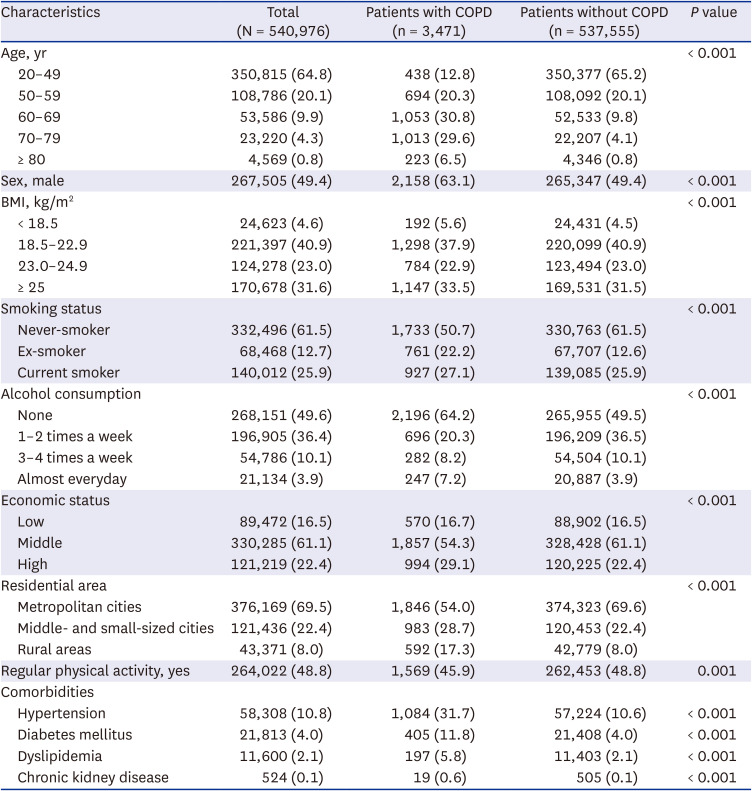

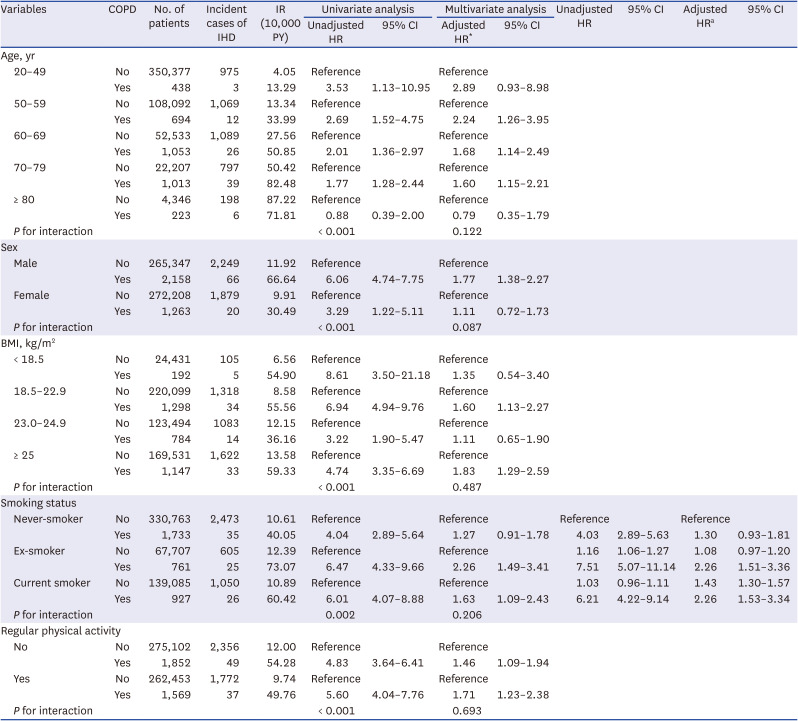




 PDF
PDF Citation
Citation Print
Print



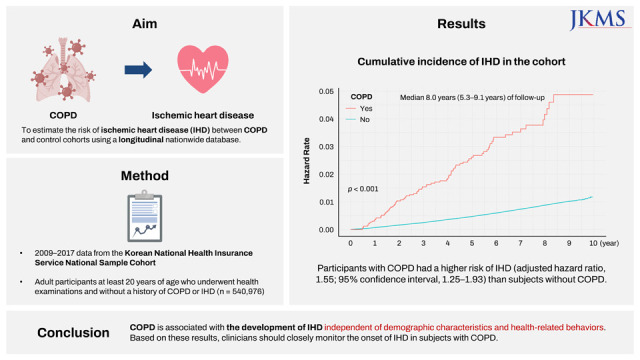
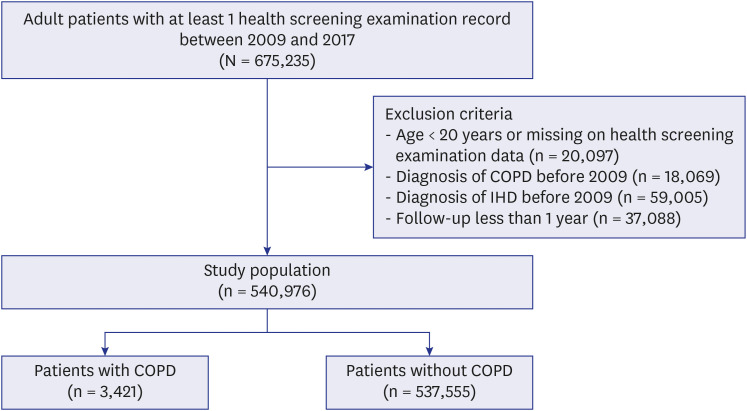
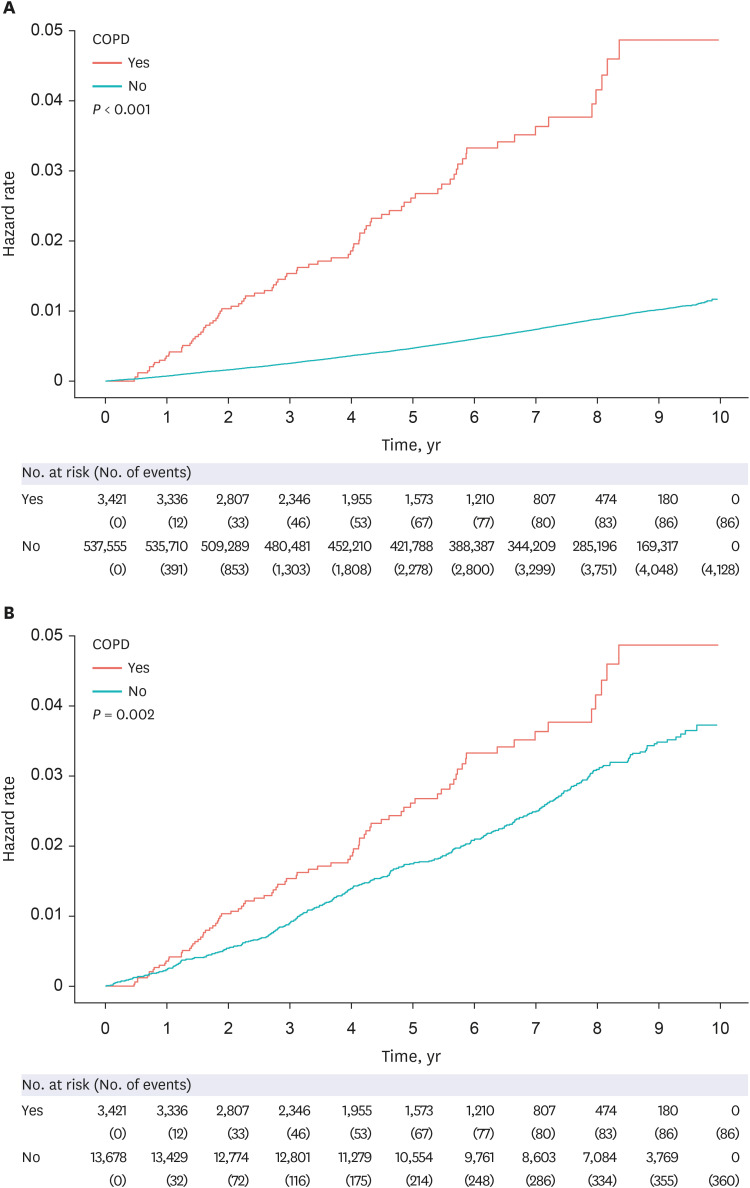
 XML Download
XML Download